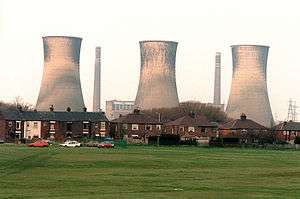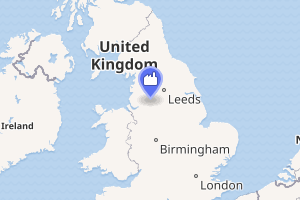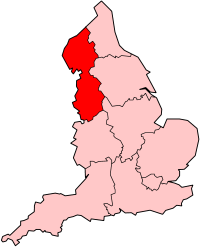Chadderton Power Station
Chadderton Power Station refers to a series of two coal-fired power stations, which were situated at Chadderton, Greater Manchester in North West England.
| Chadderton A & B power stations | |
|---|---|
 Chadderton B Power Station shortly before demolition in 1986 | |

| |
| Country | England |
| Location | Chadderton |
| Coordinates | 53.531640°N 2.165911°W |
| Status | Demolished |
| Construction began | A station: 1925 B station: 1950 |
| Commission date | A station: 1927 B station: 1955 |
| Decommission date | B station: 1982 |
| Operator(s) | Oldham Corporation 1927-1948 British Electricity Authority 1948-1955 Central Electricity Authority 1955-1957 Central Electricity Generating Board 1958-1982 |
| Thermal power station | |
| Primary fuel | Coal |
| Turbine technology | Steam turbines |
| Chimneys | A station 8, B station 2 |
| Cooling towers | A station 6, B station 3 |
| Cooling source | Circulating water cooling towers |
| Power generation | |
| Units operational | B station: Four 60 MW Metropolitan-Vickers |
| Units decommissioned | All decommissioned |
| Nameplate capacity | B station: 240 MW |
| Annual net output | 893.96 GWh (1971), 109.13 GWh (1981) |
| External links | |
| Commons | Related media on Commons |
grid reference SD891039 | |
Slacks Valley (Chadderton A) Power Station
History
The first power station to be constructed at Chadderton was built around 1925–1929 and was commissioned in November 1929 for the County Borough of Oldham in the Slacks Valley. The station was fueled by coal and had six cooling towers and eight chimneys. This station was still active in 1953 but at some time between 1959 and 1975 it was demolished.[1]
The principal plant at Chadderton A station comprised:[2]
- Eight Babcock and Wilcox 50,000 pounds per hour (6.3 kg/s) steam boilers operating at 275 psi and 700°F (18.96 bar and 371°C) with chain grate stokers,
- Three 13.75 MW Metro-Vickers turbo-alternators (6.6 kV), total capacity 41.25 MW,
- Six Premier chimney type cooling towers with a capacity of 1.8 million gallons per hour (2.27 m3/s).
The electricity output from Chadderton A power station was:[2][3][4]
| Year | Station output GWh | Thermal efficiency, % |
|---|---|---|
| 1946 | 97.91 | 17.14 |
| 1953/4 | 73.16 | 16.83 |
| 1954/5 | 46.23 | 16.02 |
| 1955/6 | 19.03 | 14.67 |
| 1956/7 | 52.78 | 16.91 |
| 1957/8 | 22.81 | 14.89 |
| 1960/1 | 5.12 | 11.25 |
| 1961/2 | 8.82 | 11.57 |
| 1962/3 | 17.14 | 12.24 |
Chadderton B Power Station
History
Development
In 1943, Oldham Corporation investigated the anticipated growth of load on their distribution area, and so a scheme was prepared to replace the existing Slacks Valley station. The preparation plan, drawn up by Kennedy & Donkin, considered other sites for the replacement but decided that the existing site at Chadderton was the most suitable, with an envisaged capacity of 120,000 kW, using four 30,000 kW turbo-alternators, installed at intervals of two at a time. However following discussion with the then Central Electricity Board, this was revised to four 50,000 kW sets, giving the station a capacity of 200,000 kW. This was revised again with the standardisation of unit sizes and operating temperatures and pressures, meaning the sets ended up each being 60,000 kW in size.
Surveying of the site had indicated that the site, some 95-acre (38 ha) in size, was of ample area for the scale of the new development. The site was partly made up of waste ground, having previously been used as an aircraft factory, and later as a cotton storage area by the Cotton Board. It also remained occupied by the low pressure Slacks Valley power station and its 132 kV transformer compound. It was found that suitable rail facilities for the new station were obtainable from the adjacent Caldervale Line. It was also found that effluent from the Oldham Corporation's Sewage Works could be used as make-up for the station's cooling towers. These factors helped in the station going ahead. The station was to be built in two phases, the first phases was granted consent in January 1950, and the second phase in September that year.
Chadderton B Power Station was officially opened on 8 July 1955 by Councillor F. Kenyon, chairman of the North Western Electricity Consultative Council, and member of the North Western Electricity Board.[1][5][6][7][8] The principal plant comprised:[2]
- Seven pulverised fuel boilers (Simon-Carves) delivering 360,000 lb/hr (45.4 kg/s) of steam at 900 psi and 900°F (62.1 bar and 482°C),
- Four 60 MW Metropolitan-Vickers turbo-alternators (11.8 kV) with step-up transformers to 33 kV,
- Three cooling towers each 3.5 million gallons per hour (4.42 m3/s).
Operations
The electricity output from Chadderton B power station was:[2][9][10][3]
| Year | Station output, GWh | Thermal efficiency, % |
|---|---|---|
| 1953/4 | 8.59 | 26.72 |
| 1954/5 | 543.52 | 26.91 |
| 1955/6 | 770.27 | 27.50 |
| 1956/7 | 555.23 | 27.09 |
| 1957/8 | 929.86 | 27.61 |
| 1960/1 | 1226.6 | 27.41 |
| 1961/2 | 1109.3 | 26.84 |
| 1962/3 | 1231.7 | 27.15 |
| 1971/2 | 893.96 | 25.47 |
| 1978/9 | 545.307 | 24.71 |
| 1981/2 | 109.128 | 21.57 |
In 1971 the 7 boilers at Chadderton’B’ had a combined steam generating capacity of 2.52 million pounds per hour (317.5 kg/s).[9] The steam conditions were 900 psi (62.1 bar) and 482°C. The station generated electricity using four turbo-alternators, each with a capacity of 63 megawatts (MW), giving the station a total generating capacity of 252 MW. The station was planned to use eight boilers, but only seven were ever installed.[1]
The railway sidings that serviced the previous station were extended. Four locomotives worked the coal yard.[11]
Closure and demolition
Structural changes to the National Grid made the power station redundant in 1982.[12] It closed on 1 November 1982 with a generating capacity of 236 MW.[13] The station and site were sold by the Central Electricity Generating Board in 1984, and demolished in April 1986.[1][6] The station was demolished by MJ Finnigan & Co.[14] Much of the site has been redeveloped with European Union and UK Government funding to become Oldham Broadway Business Park.
The electrical substation was left in place after the demolition of the main generating station but, because of the deteriorating concrete structure and poorly performing switchgear, it has been replaced by a £25million indoor gas insulated switchgear substation on the same site.[15][16]
References
- Department of the Environment (1994), Documentary Research on Industrial Sites: CLR Report 3 (PDF), eugris.info
- Garrett, Frederick C. (ed) (1959). Garke's Manual of Electricity Supply vol.56. London: Electrical Press. pp. A-44, A-117.CS1 maint: extra text: authors list (link)
- GEGB Annual report and accounts, various years
- Electricity Commission, Generation of Electricity in Great Britain year ended 31st December 1946. London: HMSO, 1947.
- Chadderton B Power Station, Central Electricity Authority, 1955
- Lawson & Johnson 1997, p. 2.
- India-Rubber Journal, 125, July–December 1953, p. 291
- Museum of Science and Industry in Manchester (2001). "Power Stations in Greater Manchester" (PDF). msim.org.uk. Archived from the original (PDF) on 25 October 2007. Retrieved 23 December 2008.
- CEGB (1972). CEGB Statistical Yearbook 1972. London: CEGB. p. 17.
- CEGB (1982). CEGB Statistical Yearbook 1981-82. London: CEGB. p. 8. ISBN 0902543695.
- Wells, p. 86
- Lawson & Johnson 1997, p. 73.
- Mr. Redmond (16 January 1984). "Coal-fired Power Stations". Hansard. Retrieved 1 September 2009.
- "MJ Finnigan Demolition". mjfdemolition.co.uk. Archived from the original on 6 October 2011. Retrieved 18 April 2011.
- "£25m power plan sparks into action", Oldham Evening Chronicle, 29 October 2008
- "Whitegate 132kV Substation" (PDF). United Utilities. Retrieved 27 February 2009.
Bibliography
- Lawson, Michael; Johnson, Mark (1997), Images of England: Chadderton, Stroud, Gloucestershire: Tempus, ISBN 0-7524-0714-7
- Wells, Jeffrey, Scenes From The Past: The Oldham Loop Part Two, Bredbury, Cheshire: Foxline, ISBN 1-870119-76-2
External links
| Wikimedia Commons has media related to Chadderton Power Station. |
- YouTube - demolition of Chadderton B's cooling towers
- Photographs - more views of the demolition

